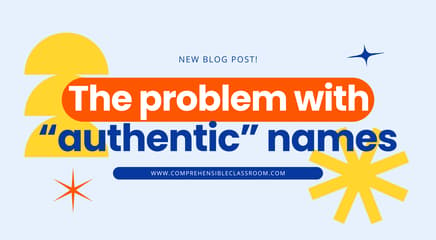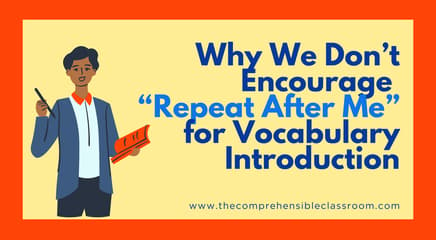The second to last session that I attended at ACTFL 2015 was with Amy Lenord. Amy has written fairly extensively on her blog about why and how she has moved away from giving traditional vocabulary lists to her students. As I was busy covering the session on Twitter (search Twitter for #unlistvocab #actfl15 for my tweets at that session), a conversation sprung up about the idea that language or vocabulary “chunks” are harder to put on a list than are vocabulary words; but that chunks of language are better to target in class than are words. One fellow tweeter asked, “Where can we learn more about language chunking?” On request, my good buddy The Great Boulanger (Minnesota’s 2016 Language Teacher of the Year and labeled as a “heavy hitter” in our profession by Dr. Stephen Krashen himself!) shared several possible resources to learn more on the subject:

I need to spend some time digging into his suggested resources, but I think it would be helpful to create a working definition of a “language chunk”. First of all, I think that you will more often hear TPRS®/CI teachers refer to “language chunks” as “target structures”. The two terms are interchangeable. Since teachers that teach with comprehensible input talk about target structures constantly, you’d think that they would be clearly defined in some blog post, somewhere. But for the life of me I can’t find one. (Maybe someone else can share a link?) So…here’s my answer to the language chunking question:

What is a target structure?
A target structure is a usable piece of language. It could be a single word, or it could be a string of words. It’s just…language! But since that’s about as clear as mud, perhaps we should just look at some examples of structures that I’ve targeted in the past:
- durante la noche / during the night
- de repente / suddenly
- ¿quieres salir conmigo? / do you want to go out with me?
- la mujer bonita / the pretty woman
- el hombre piensa que / the man thinks that
- trabaja en / he works at
- eres / you are
Each of these target structures is useable. Single words are usable, sure, but only two of the target structures that I listed are single words in either Spanish or English. All of the structures are ready to be “plugged and played”: they are ready to be used to communicate a message.
Let’s imagine that you want to tell a story about pirates playing soccer at night (por la noche, los piratas juegan al fútbol). You could prepare students by giving students a vocabulary list (on the left) or by establishing meaning for target structures (on the right):

Which list would you rather teach? The one that requires your students to learn how to combine and manipulate the words in a separate step, or the one that contains chunks of language that students can use now? There is nothing wrong with using single words at target structures…even single words that haven’t been manipulated…but those should be the minority. Here's why:
Chunking vocabulary promotes language acquisition instead of language learning
When we chunk vocabulary, students don’t have to learn the "rules" of language. When we start with individual words, students have to learn how to combine them in order to communicate meaningful messages. We have to define the term to our students, and we have to explain what needs to be done with it in order to use it to communicate a message. When we start with chunks in which the words have already been combined, they don’t have to learn how to put words together because they have already seen them in context. Instead of teaching the word for “thinks” and then teaching students that in order to say “thinks about”, you have to add the preposition “en” (in/on), I could simply combine the two words into one target structure and teach “piensa en” = thinks about. Taking apart a puzzle is much easier than putting it together: breaking apart a target structure to determine the meaning of each individual piece is much easier than starting with the pieces and trying to put them together correctly. Students can easily parse the structure and determine that “piensa” means “thinks” and that “en” can mean “about”. Another example of a target structure is “Do you want to go out with me?” (¿Quieres salir conmigo?). By combining “you want” and “to go”, you avoid the common problem of students adding the preposition “to” (a) in between the two words. And you don’t have to teach the verb “to want” (querer) and then teach its conjugation; you give the students the conjugated form. You don’t have to explicitly teach word order because students only ever see words in the correct order and acquire word order implicitly. By introducing [prepositions, articles, pronouns, etc.] to students in context, you will find that students don’t have to work to acquire them…and you don’t have to work to teach it them. They don’t have to study and memorize them and learn about how they must be used in sentences because students have only ever seen them in context; they’ve only ever seen them in use!
Chunking vocabulary shifts the focus from form to meaning
When we give a list of isolated words, we have to manipulate the form of those words first, before we can communicate a meaningful message. We force students to focus on form first before they can focus on the meaning of the message. We will almost always need to manipulate the form of the word (make a singular noun plural, conjugate the infinitive of a verb, learn where in the sentence the word must be placed, etc.) before we can use it to communicate a message. When we give them a chunk of language that doesn’t need to be manipulated in order to be used, students are able to focus on the meaning of the message first, and they focus on the form later, only after they have seen a slightly different version of that same chunk of language (ex: I eat pizza vs. she eats pizza [como pizza vs. come pizza]).
Chunking vocabulary sends the message that language is art, not math
You see, language is not composed of a system of rules. It is not composed of isolated chunks of meaning that can be combined with complicated formulas. By teaching students vocabulary (single words in their most basic form), we communicate the message that language can be created by combining ingredients as you follow a recipe. But language is art! We have unlimited mediums and materials that can be combined in an infinite number of ways. When the starting point for a new structure is a conjugated verb or a combination of words, we communicate the message to students that language is a creative process. When the starting point for a new structure is a single vocabulary word, always given in the same form (article + noun “el circo”, infinitive “beber”), we communicate the message that language is a mathematical equation.
The bottom line
My point is…well…language chunks are just…language. Language that you can use. They are whatever you want them to be; whatever makes sense for you to communicate your message to your students. Realizing that you have the freedom to determine how to present language to your students will help your students see that they have the freedom to create with the language, too.




